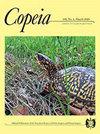利用虹膜生物识别大西洋鲑鱼个体
IF 2.6
Q2 Agricultural and Biological Sciences
引用次数: 1
摘要
传统的鱼类标签方法可能存在与动物福利和经济成本相关的问题。生物特征数据,如虹膜模式,可以通过数码相机捕获,这允许非侵入性标记和廉价和快速的分析。本研究的目的是研究大西洋鲑鱼(Salmo salar)的虹膜是否适合作为个体长期识别的生物特征模板。在大西洋鲑鱼幼鱼孵化前的阶段,使用PIT标签在体腔中单独标记,并在533天的时间内拍摄了六次左眼。定性和使用虹膜识别软件评估虹膜稳定性的变化。在整个时期内,利用虹膜鉴定大西洋鲑鱼个体并不成功,因为虹膜的模式随着时间的推移而发生了显著变化。在较短的时间内(4个月)频繁取样,虹膜软件能够正确识别个体鱼。结果表明,虹膜识别有可能在短时间内取代大西洋鲑鱼的其他方法。本文章由计算机程序翻译,如有差异,请以英文原文为准。
Individual Recognition of Atlantic Salmon Using Iris Biometry
Traditional tagging methods for fishes can have issues relating to both animal welfare and economic costs. Biometric data such as iris patterns can be captured via digital cameras, which allows for non-invasive tagging and inexpensive and rapid analysis. The purpose of this study was to investigate if the iris of Atlantic Salmon (Salmo salar) is a suitable biometric template for long-term identification of individuals. Atlantic Salmon were individually tagged in the body cavity using PIT tags at the juvenile pre-smolt stage, and the left eye was photographed six times over a 533-day period. Changes in iris stability were assessed both qualitatively and using iris-recognition software. Identification of individual Atlantic Salmon using the iris was not successful over the entire period, as the iris pattern changed significantly with time. Over a shorter time period (four months) with frequent samplings, iris software was able to correctly identify individual fish. The results show that iris identification has potential to replace other methods for Atlantic Salmon over short timeframes.
求助全文
通过发布文献求助,成功后即可免费获取论文全文。
去求助
来源期刊

Copeia
生物-动物学
CiteScore
2.10
自引率
0.00%
发文量
0
审稿时长
6-12 weeks
期刊介绍:
Founded in 1913, Copeia is a highly respected international journal dedicated to the publication of high quality, original research papers on the behavior, conservation, ecology, genetics, morphology, evolution, physiology, systematics and taxonomy of extant and extinct fishes, amphibians, and reptiles. Copeia is published electronically and is available through BioOne. Articles are published online first, and print issues appear four times per year. In addition to research articles, Copeia publishes invited review papers, book reviews, and compiles virtual issues on topics of interest drawn from papers previously published in the journal.
 求助内容:
求助内容: 应助结果提醒方式:
应助结果提醒方式:


